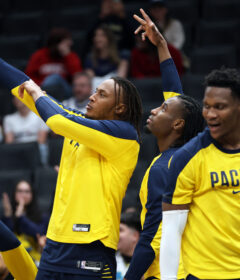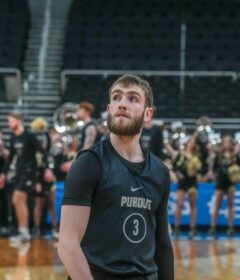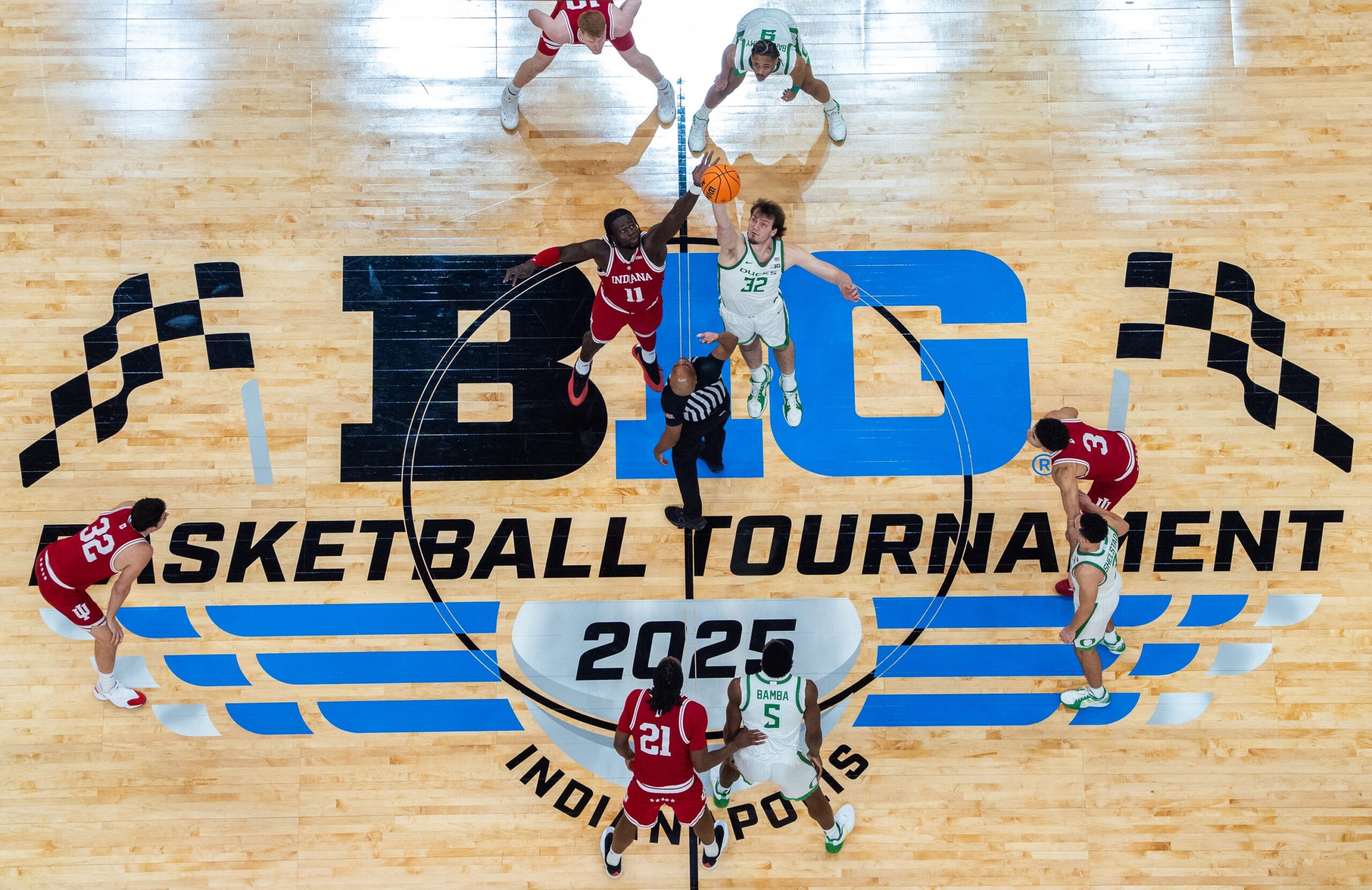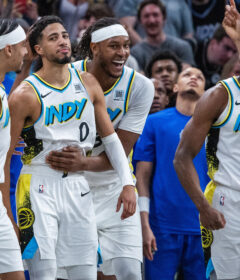Notre Dame beats Stanford with memorable goal-line stand in OT
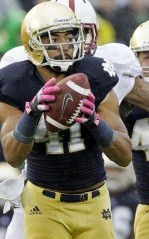
By DOUG GRIFFITHS
ISL Correspondent
NOTRE DAME, Ind. — Notre Dame’s magical season got even more magical on Saturday evening thanks to a thrilling 20-13 overtime win over No. 17 Stanford in Notre Dame Stadium.
The story was once again the Irish defense.
It’s a defense that prior to the Stanford game was considered one of the nation’s best. Afterwards, it probably should be considered the best. Sorry, Alabama.

After the Irish took at 20-13 lead in overtime on a Tommy Rees to TJ Jones 7-yard touchdown pass play, Stanford appeared as though it would tie the game and send it into a second extra session.
Facing the end zone closest to Notre Dame’s student body and Touchdown Jesus, the Cardinal had the ball first-and-goal from the Irish 4.
With one of the nation’s best running backs in Stepfan Taylor, you would think a few running plays would deliver Stanford into the end zone.
First down resulted in a one-yard gain. Second down got two yards. Third down came inside the 1 and it, too, was stuffed, setting up a dramatic fourth-down situation.
With the sellout crowd of 80,795 on its feet and somewhat deafening as Stanford prepped for the critical snap in the north end of the Stadium, the Cardinal again turned to Taylor.
Cornerback Bennett Jackson came off the edge from the left side slowing Taylor’s progress and the Irish defensive line got excellent push. Taylor hit a brick wall and was stopped. One of the most memorable goal-line stands in Notre Dame history prompted a mass celebration as the Irish bench poured onto the field.
The game was over, right? Wrong.
Referee Shawn Hochuli, the son of famous NFL referee Ed Hochuli, got on the public address system, telling the teams to return to their respective benches saying the play was under further review and the ruling on the field was the runner was stopped short of the goal line.
Replays showed Taylor was stopped initially, began falling to the ground, but was never down as he was on top of a lineman and spun off and appeared to reach the ball out and cross the plane of the goal line for a touchdown. His initial forward progress was stopped and the crowd noise made it so loud that you could never have heard when the officials’ whistle initially blew.
As Hochuli stepped back onto the field, he told the crowd, “There is no excessive celebration on the play because both teams thought the game was over.” The interesting thing about that statement was there was no flag thrown on the play. He continued by saying, “The call on the field stands.”
Once those words were uttered it set off quite the celebration as you could imagine. Some students spilled out onto the field. The rain began to come down even harder than it had before, but that didn’t dampen the spirits of the excited Notre Dame faithful. At one point, there were so many fans on the field that they took up half of it.
“Football is a game of inches,” Irish linebacker Manti Te’o said, “and you’re fighting and our guys had him on his legs holding up. I was just glad I got in there.”
“It was pretty apparent to me that the play was over,” said Irish coach Brian Kelly afterwards. “I think that’s what everybody saw; so that play was over.
“It was just a great college football game. It was a great win.”
When asked about Stanford’s play selection of running the ball inside the 5 in overtime, Kelly said he wasn’t surprised at all since that’s what Stanford does.
“I don’t think you can fault them for doing what they do,” Kelly said. “That’s their offense. Look, they ran an inside power play all the way down to the 3-yard line.
“We were loaded up. And just controlled the line of scrimmage in those situations.”
Te’o said Notre Dame was focused on Taylor carrying the ball on the last few plays.
“We knew that basically No. 33 was going to have the ball so everybody knew their job,” Te’o said. “We knew they were going to run the ball.”
One of the many things impressive about the goal-line stand was it came against an offensive line that features two players that will be playing in the NFL in David Yankey and Cameron Fleming.
The goal-line stand for the ages kept Notre Dame’s defense’s streak of not allowing a touchdown alive. Purdue is the last team to have scored an offensive touchdown against the Irish, who still have not allowed a rushing touchdown this season.
In the post-game press conference, Stanford coach David Shaw was asked about Notre Dame’s defense and he said he wasn’t there to talk about the Irish.
The win improved No. 7 Notre Dame to 6-0 on the season, while Stanford fell to 4-2.
Overtime started with Rees getting clobbered by linebacker Trent Murphy for a seven-yard loss. Following a nine-yard pass play, the Irish were faced with third-and-eight from Stanford’s 23.
It was on the next play that you started to think the game had swayed in Notre Dame’s favor. Rees dropped back and threw off his back foot under pressure. The ball was so poorly thrown that the Cardinal defensive back really didn’t have a chance. Running back Theo Riddick adjusted to the ball in flight, coming back for it and making a 16-yard catch for a first down.
Notre Dame’s next snap resulted in Rees’ touchdown pass to Jones.
Both teams’ defenses controlled the offenses.
Notre Dame finished with 334 yards, with 228 of those coming

in the second half and overtime. The Irish were pretty balanced with 150 coming on the ground and 184 passing.
Stanford was held to 272 yards, including just 125 through the air.
Cierre Wood was Notre Dame’s leading rusher with 66 yards on 12 carries.
Golson completed 50 percent of his 24 passes to end with 141 yards and was sacked three times.
In relief of Golson, Rees was a perfect 4-for-4 for 43 yards.
Stanford quarterback Josh Nunes completed just 12-of-25 passes and threw a pair of interceptions.
The Cardinal’s best offense was Taylor, who ran for 102 yards, but he needed 28 carries to top the century mark.
The Irish trailed the game 10-3 late in the third quarter when tight end Tyler Eifert made Notre Dame’s best catch of the season. It came on third-and-18. On the next play, quarterback Everett Golson threw to Eifert, who made a terrific leaping grab at the goal line and fell into the end zone to knot the score at 10 just 45 seconds into the fourth quarter.
The Cardinal responded on their next possession by driving down the field to set up a 27-yard field goal with just over six minutes remaining, giving the visitors a 13-10 lead. The drive took more than eight minutes off the clock and took 16 plays.
Notre Dame’s ensuing possession saw the Irish drive into field goal range in the waning moments of regulation.
Notre Dame played it somewhat safe as to not turn the ball over running it three straight times when it had the ball first-and-10 from Stanford’s 12.
Kyle Brindza’s 22-yard field goal tied the game at 13 with just 20 seconds left in regulation.
On the scoring drive, Golson was knocked out of the game with an apparent head injury that resulted in a personal foul penalty on Stanford for helmet-to-helmet contact. Kelly said on the sideline Golson was complaining about blurred vision on the sideline and the medical staff did not clear him to return to action.
Stanford simply took a knee on its next series and the game was headed into overtime.
The Irish offense didn’t play well at all for the first two-and-a-half quarters. After losing just one fumble this season, they lost three fumbles, one of which came in the end zone and resulted in a Stanford touchdown, which gave the Cardinal a 7-3 second-quarter lead. It was the first time all season Notre Dame had been behind in a game.
After another Notre Dame error — this time a bad snap on a 28-yard field goal try — the Cardinal moved 44 yards in seven plays and took a 10-3 lead into the locker room when kicker Jordan Williamson connected on a career-long 48-yard field goal as time expired.
Notre Dame’s offense couldn’t get untracked in the opening 30 minutes. The Irish were held to a mere 106 total yards on 35 snaps, including 45 yards rushing on 19 attempts.
Golson was just 6-of-16 passing and was sacked twice.
The Irish best offense was when Golson would create on his own, scrambling to avoid Stanford’s constant pressure and tucking the ball and running. Golson had Notre Dame’s longest play from scrimmage in the first half, a 23-yard run.
An interception led to Notre Dame’s first score of the game, which was a 29-yard field goal by Brindza, which gave the hosts a 3-0 lead with 36 seconds left in the first quarter.
The Irish will enjoy this victory for 24 hours or so and get back to work, focusing on next week’s home game against BYU.
Also:
Wisconsin crushes Purdue
Follow Doug Griffiths on Twitter: www.twitter.com/ISLgriffiths.

